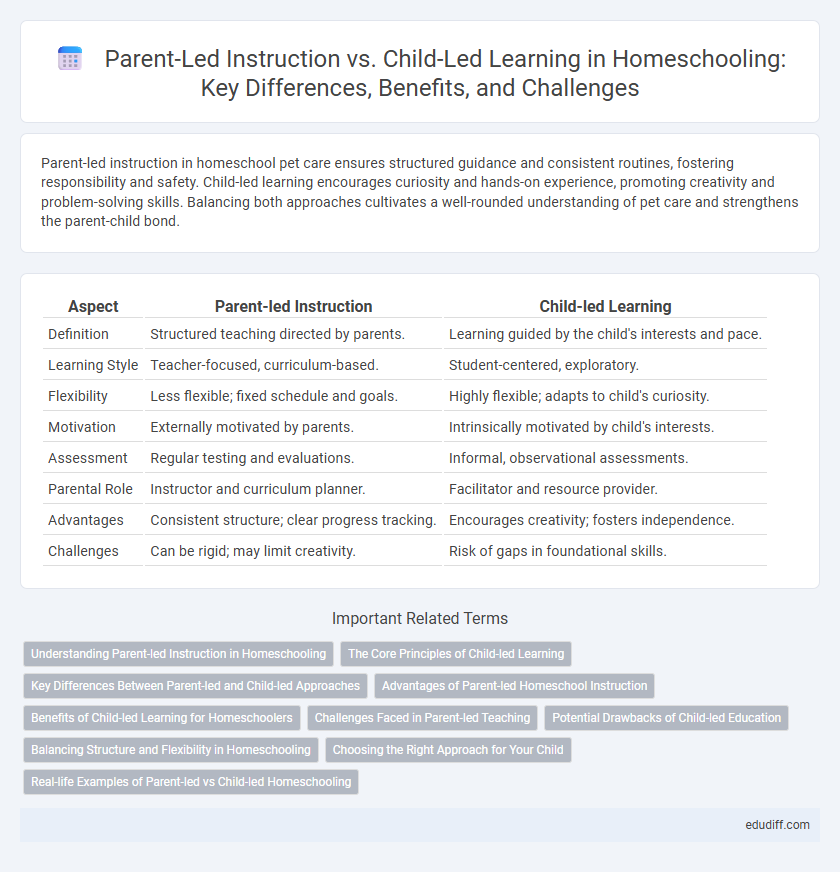Parent-led instruction in homeschool pet care ensures structured guidance and consistent routines, fostering responsibility and safety. Child-led learning encourages curiosity and hands-on experience, promoting creativity and problem-solving skills. Balancing both approaches cultivates a well-rounded understanding of pet care and strengthens the parent-child bond.
Table of Comparison
| Aspect | Parent-led Instruction | Child-led Learning |
|---|---|---|
| Definition | Structured teaching directed by parents. | Learning guided by the child's interests and pace. |
| Learning Style | Teacher-focused, curriculum-based. | Student-centered, exploratory. |
| Flexibility | Less flexible; fixed schedule and goals. | Highly flexible; adapts to child's curiosity. |
| Motivation | Externally motivated by parents. | Intrinsically motivated by child's interests. |
| Assessment | Regular testing and evaluations. | Informal, observational assessments. |
| Parental Role | Instructor and curriculum planner. | Facilitator and resource provider. |
| Advantages | Consistent structure; clear progress tracking. | Encourages creativity; fosters independence. |
| Challenges | Can be rigid; may limit creativity. | Risk of gaps in foundational skills. |
Understanding Parent-led Instruction in Homeschooling
Parent-led instruction in homeschooling involves structured lessons where the parent actively directs the learning process, setting clear goals and pacing to ensure curriculum standards are met. This approach allows parents to tailor content to their child's academic needs while maintaining control over educational outcomes and consistency. Research shows that parent-led methods can improve foundational skills such as literacy and numeracy by providing systematic guidance and immediate feedback.
The Core Principles of Child-led Learning
Child-led learning centers on the core principles of autonomy, curiosity, and personalized pacing, allowing children to explore subjects based on their interests and natural development rhythms. This approach fosters intrinsic motivation, critical thinking, and a deeper understanding by encouraging active engagement and self-directed problem-solving. Parents act as facilitators rather than instructors, providing resources and support tailored to each child's unique learning journey.
Key Differences Between Parent-led and Child-led Approaches
Parent-led instruction in homeschooling involves structured lessons and curriculum designed by parents, emphasizing consistency and academic goals, while child-led learning prioritizes the child's interests and pace, fostering autonomy and intrinsic motivation. Parent-led approaches typically use set schedules and assessments to measure progress, whereas child-led methods rely on exploration and natural curiosity to guide learning experiences. These differences highlight the contrast between directive guidance and flexible, interest-driven education tailored to individual learning styles.
Advantages of Parent-led Homeschool Instruction
Parent-led homeschool instruction allows for structured curriculum tailored to the child's academic needs and pacing, ensuring consistent progress in core subjects like math, reading, and science. Parents can directly monitor and adjust teaching methods to suit their child's learning style, promoting deeper understanding and retention. This approach also fosters strong parent-child bonds and provides a controlled learning environment free from external distractions.
Benefits of Child-led Learning for Homeschoolers
Child-led learning in homeschooling fosters intrinsic motivation by allowing children to explore subjects aligned with their interests, which enhances engagement and retention. This approach promotes critical thinking and problem-solving skills as students navigate their educational paths independently, tailoring learning to their unique pace and style. Research shows that child-led learning supports deeper understanding and fosters creativity, essential benefits for developing lifelong learners in a homeschool environment.
Challenges Faced in Parent-led Teaching
Parent-led instruction in homeschooling often encounters challenges such as balancing teaching responsibilities with household management, which can lead to caregiver burnout. Parents may struggle with limited expertise in certain subject areas, affecting the quality of education and student engagement. Time management difficulties and lack of access to diverse teaching resources further complicate maintaining consistent and effective instruction.
Potential Drawbacks of Child-led Education
Child-led learning in homeschool settings may lead to gaps in foundational knowledge due to inconsistent coverage of essential subjects. Without structured guidance, children might struggle with time management and prioritizing academic goals, potentially hindering long-term educational progress. Lack of parental oversight can result in reduced accountability and difficulty in assessing learning outcomes effectively.
Balancing Structure and Flexibility in Homeschooling
Balancing structure and flexibility in homeschooling requires blending parent-led instruction with child-led learning to optimize educational outcomes. Parent-led instruction provides essential structure through organized lesson plans and clear objectives, ensuring curriculum standards are met. Child-led learning fosters creativity and engagement by allowing students to explore interests at their own pace, promoting intrinsic motivation and deeper understanding.
Choosing the Right Approach for Your Child
Parent-led instruction provides structured curriculum and clear goals, ideal for children who thrive with guidance and routine. Child-led learning encourages exploration and creativity, suiting independent learners who benefit from autonomy and curiosity-driven activities. Selecting the right homeschool approach depends on assessing your child's learning style, needs, and motivation to create an effective and engaging educational environment.
Real-life Examples of Parent-led vs Child-led Homeschooling
Parent-led homeschooling often involves structured schedules where parents design daily lessons, as seen in families using classical curricula like the Well-Trained Mind. Child-led learning emphasizes student autonomy, with examples including unschooling approaches where children pursue interests such as coding or nature studies at their own pace. Real-life comparisons highlight that parent-led instruction can lead to measurable academic progress, while child-led methods foster creativity and intrinsic motivation.
Parent-led Instruction vs Child-led Learning Infographic

 edudiff.com
edudiff.com